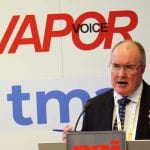Congress Tackles Challenges and Opportunities
- Print Edition TABEXPO
- December 1, 2019
- 0
- 10 minutes read

The TABEXPO congress tackled the challenges and opportunities in a rapidly evolving industry.
By Arpi Shively
From production automation advances to digital packaging that talks and from building trust to tobacco company transformation, the TABEXPO 2019 congress in Amsterdam (Nov. 12–14) looked at the challenges and changes taking place in today’s tobacco and nicotine businesses.
“Businesses need to balance the brave new world of emerging products and the familiar world of tobacco,” said congress master of ceremonies Simon Clark, director of Forest and advocate for the right to enjoy smoking and vaping. The first morning focused on tobacco and emerging products, hearing from those involved in the supply chain.
Jeroen Slobbe, a board member of ITM Group, reviewed trends and developments in tobacco and nicotine production automation. He highlighted the need to partner more closely with customers and to pursue ever more stringent quality standards for pharmaceutical level reporting requirements to comply with tightening regulations. ITM Group is betting on a modular approach in creating new equipment that meets fast-changing customer needs. Slobbe used the analogy of Lego bricks, each with individual capabilities that can be bolted together to provide maximum flexibility.
Speaking for the Indonesian paper and packaging manufacturer BMJ, business development director Liem Khe Phung echoed the need to respond to customization requirements with ingenuity and at speed. He unveiled BMJ’s digital printing solution. It dispenses with the need to produce and store dyes, is environmentally friendly and can accommodate last minute changes with its quick machine setup. Design and specifications can all be conducted online, including a 3D preview of the finished packaging. Actions that used to take seven days from concept to object can now be done in eight hours.
Anna Ostergren, personal communications expert at Armatos, took up the theme of trust, which has become more important than ever as change speeds up. Ostergren shared the subtle physical and linguistic ways in which manufacturers and suppliers can convey confidence in their businesses and products.
Creating trust was also an important thread in the Supplier Focus panel at the end of the first morning. Moderator Christopher Greer, president and CEO of TMA, quizzed panelists on current concerns and future plans. Linda Crumpler of Cerulean said that innovation in e-cigarettes and vaping has almost outpaced the technology. There was consensus that though change is unavoidable and accelerating, measurement technology and results must remain stable and reliable. Dora Gleoudis of Nicos Gleoudis Kavex spoke of the challenges facing farmers in balancing social responsibility and regulatory demands in a shrinking market. Victor Dixon of tobacco packaging experts LLFlex emphasized the need to anticipate “the new,” even beyond tobacco, and help customers to reinvent at speed. All agreed that suppliers must become trusted solution providers.
James Millard of NDC Technologies spoke of the need for leaf suppliers and next-generation product manufacturers to switch from a tech-driven focus to a market-driven focus and to partner with tech companies earlier in the product cycle. Asked to identify the positives of living through “interesting times,” all spoke of change providing the impetus to step out of their comfort zones—a movement that often resulted in improved products and performance.
The second morning of the congress was devoted to next-generation products and the associated global challenges. Michiel Reerink, vice president of global regulatory strategy at Japan Tobacco International, looked ahead to the ninth Conference of the Parties (COP9) of the World Health Organization’s (WHO) Framework Convention on Tobacco Control (FCTC), scheduled to convene in the Netherlands in May 2020. The FCTC continues to drive regulation worldwide. According to Reerink, plain packaging continues to spread slowly, though the measure has yet to prove itself effective as a tool to reduce smoking.
Even as stakeholders are still evaluating the impact of the 2014 revised EU Tobacco Product Directive (TPD2), TPD3 is already taking shape. The new directive will cover e-cigarettes for the first time, and the full impact of TPD3 will become clear by 2022–2024. Will EU countries follow the lead of the U.K. with its relative tolerance of e-cigarette use or that of the U.S., which has been imposing restrictions on alternative products, good, bad and ugly alike?
Stavroula Anastasopoulou, senior market analyst for ECigIntelligence, depicted a highly fragmented EU e-cigarette market worth €3.8 billion ($4.15 billion) in 2019. It is led by the U.K., which at €1.2 billion a year in revenues accounts for more than one-third of this market, far ahead of France, Italy, Germany and Poland. The most recent consumer surveys in these latter countries reveals that quitting smoking is still the No. 1 reason people use e-cigarettes.
Vape stores have suffered from the recent negative publicity around e-cigarettes in the U.S., with U.K. stores reporting around 25 percent less revenue in October. Online channels, currently responsible for 35 percent of distribution, are predicted to shrink as regulation bites while convenience stores, now doing just 15 percent of the sales, are set to grow as pod and e-liquid brands enter this channel. In fact, open pods and pod devices hold a promise of future growth, according to Anastasopoulou.
From statistics to science, Sarah Cooney, head of scientific collaboration and communication at British American Tobacco (BAT), outlined how BAT is embracing the nicotine-delivery revolution, using consumer-driven and technology-driven disruption to transform the nicotine marketplace. BAT is working on new technologies, including a new smokeless product called Epok, and a way of extracting flavor directly from the tobacco leaf. Consumer safety is keeping pace with innovation: Scientific data from BAT’s Vype device offers the single largest data set for any e-cigarette product, paving the way for it to be demonstrated as potentially reduced risk, according to Cooney.
These are exciting developments, although the next speaker sounded a note of caution with regard to the U.S. regulatory framework. Maggie Gowen, executive director of the Global Vaping Standards Association (GVSA), spoke of a difficult environment for the U.S. vapor industry, intensified in recent months by the THC vaping crisis. When the Food and Drug Administration (FDA) and Centers for Disease Control and Prevention (CDC) failed to make a clear distinction between THC and all other vapor products, the resulting media frenzy resulted in statewide flavor bans and a hardening of negative sentiment around the products. The impact has bitten fast and bitten deep: In Ohio, more than 20 percent of vape stores have already closed, according to Gowen. Not before time, the CDC has clarified THC as the harmful element, and it remains to be seen if consumer confidence returns.
Youth usage is another issue creating negative headlines, said Gowen. Uptake is rising with more than 5.3 million teens reporting using e-cigarettes in the U.S. Flavors are not the only contributing factor. High nicotine content, relative lack of age controls for purchasers and the cool image promoted by some advertisers all play into the surge in younger vapers. The GVSA promotes “smart and reasonable standards” and focuses on “safety first” to address these concerns.
“Follow the money,” urged Delon Human in a bracing presentation looking at vested interests by the pharmaceutical industry and governments in the discussion about vaping. He warned against vapor companies accepting blame too readily, especially at the upcoming COP9 meeting in 2020 and urged the sharing of facts and rich data with regulators. Human likened knee-jerk bans on flavors and vaping to banning peanuts worldwide because a few people are highly allergic to them. He called the bans a tragic development for adults who want to quit smoking or switch from combustible products. Instead, he urged evidence-based debate and peer-reviewed data leading to clear, science-based risk evaluation and guidelines.
Yushu Zhu, director of Ruvian Technology, explored new fields to conquer in his presentation on reconstituted hemp in traditional products, e-cigarette products and vapor products. Over the past 20 years, process and product have been refined to create better aroma and flavor and raise the overall performance of hemp cigarettes and slow-release heated products, he noted.
Global nicotine and tobacco investment consultant Erik Bloomquist pointed out that there were no longer any certainties in the tobacco space. He cited slowing growth in key markets for vapor and heated-tobacco products and a gloomy outlook for the vapor market in particular.
As for combustible cigarettes, Bloomquist revealed eroding support from traditional allies, such as labor unions and even tobacco farmers, against a background of increasing tax burdens and regulation. He warned that the FDA was likely to enforce premarket tobacco product application (PMTA) requirements immediately for all flavors except tobacco and menthol (even the latter could be revisited and disallowed) and to go with the prohibitionist drive of the WHO and influential nongovernmental organizations such as Bloomberg. With few but the largest companies able and ready to comply with PMTA requirements, smaller vapor businesses would be pushed out of the picture, according to Bloomquist.
To close the second morning, Marcus Navin Jones, a partner in the specialist law firm Keller & Heckman, reviewed the main challenges facing the EU vapor industry in terms of emerging TPD regulations, such as enhanced product safety, quality, packing and labeling, and reporting requirements. Member states have discretion to impose elements of the regulations—and bear commensurate responsibility.
The third and final day of the TABEXPO congress was more upbeat with Patrick Basham asking, “How high can the tobacco and nicotine industries get?” regarding the rapidly growing legal cannabis market. Basham believes that tobacco-derived expertise in areas like compliance, supply chain management and track-and-trace technology means that tobacco and nicotine companies are well-placed to seize this golden opportunity.
Finally, another kind of industry transformation was presented by the Foundation for a Smoke-Free World. The foundation’s Tobacco Transformation Index will evaluate 15 of the world’s leading tobacco companies, tracking their progress toward a smoke-free world. Working with market research expert Euromonitor and advisory firm SustainAbility, their first report will be published in 2020 with regular updates thereafter. The index will also review actions of around 36 countries to assess their contribution to the smoke-free world the foundation is aiming for “within this generation.”
Simon Clark summed up the congress content as a reflection of tobacco and nicotine engaging with tightening regulation, accelerating innovation and, in some cases, sheer survival. He ended on a positive note, citing the industries’ resilience and ability to adapt. Will these qualities be even more in evidence at the next TABEXPO congress? Those exhibiting at and attending that event will be doing their best to ensure that they are.








